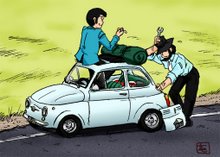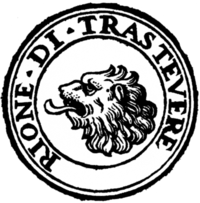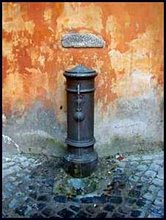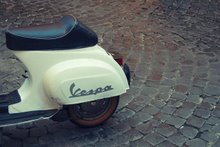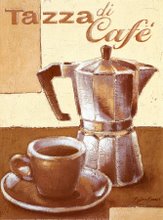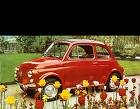Romans adore playing with words and give picturesque name to the monuments...
For example, look at the image below….
For example, look at the image below….
 Look at the animal who is carrying the obelisk, may you seen something like a piggy?!
Look at the animal who is carrying the obelisk, may you seen something like a piggy?!No, absolutely no.
 Well, the question is: if the image represent an elephant, why ever do romans call the monument “Il porcino della Minerva”(the Minerva's piggy)?
Well, the question is: if the image represent an elephant, why ever do romans call the monument “Il porcino della Minerva”(the Minerva's piggy)?Beware: “porcino” cames from the roman dialect and means a piggy; today, for phonetic reasons, we usually call it “pulcino” that means a chicken (in roman dialect Pulcino is pronounced Purcino, i.e. very similar to the nickname). A piggy, a chicken but…where is the elephant?!
Absolutely misleading! ;-)
The monument stands in piazza della Minerva, just behind the Pantheon, right in front of St.Mary Over Minerva, a Dominican church whose name comes from the fact that it was built over the ruins of a temple dedicated to Minerva, roman goddess of knowledge.
 In 1665, a small obelisk inscribed with hieroglyphs was discovered in a garden belonging to the Dominican monastery. For this reason pope Alexander VII decided to have it raised in front of the same church. To choose a base for the obelisk, a number of designs were presented to the papal commission. One of them was by a Dominican priest, Father Domenico Paglia, who was also an architect. According to his project, the obelisk would have rested over six small hills (the same hills featured in the crest of the Chigi family, whom Alexander VII belonged to), with a dog on each corner; the dog is the symbol of Dominican priests, the name cames from latin Domini canes, i.e. "the Lord's dogs", to remark their fidelity.But the pope rejected this design, as he wanted the statue to be a symbol of the Holy Knowledge, to recall the original dedication of this site. The famous artist Bernini was asked to devise a different solution. He presented several drawings, among which one featuring an elephant
In 1665, a small obelisk inscribed with hieroglyphs was discovered in a garden belonging to the Dominican monastery. For this reason pope Alexander VII decided to have it raised in front of the same church. To choose a base for the obelisk, a number of designs were presented to the papal commission. One of them was by a Dominican priest, Father Domenico Paglia, who was also an architect. According to his project, the obelisk would have rested over six small hills (the same hills featured in the crest of the Chigi family, whom Alexander VII belonged to), with a dog on each corner; the dog is the symbol of Dominican priests, the name cames from latin Domini canes, i.e. "the Lord's dogs", to remark their fidelity.But the pope rejected this design, as he wanted the statue to be a symbol of the Holy Knowledge, to recall the original dedication of this site. The famous artist Bernini was asked to devise a different solution. He presented several drawings, among which one featuring an elephant The pope chose this one, as an allegorical representation of fortitude: "...a strong mind is needed to support a solid knowledge", reads the inscription on one side of the base.
The pope chose this one, as an allegorical representation of fortitude: "...a strong mind is needed to support a solid knowledge", reads the inscription on one side of the base.In the sculptor's original plan the obelisk would have fully rested on the elephant's legs, without a stand below the animal. But Father Paglia, who was rather envious for having his project been rejected, argued that according to traditional canons, by which no weight should rest vertically above an empty space, as it would not be steady nor long-lasting, a cube should have been inserted under the elephant's belly
Bernini strongly opposed this alteration but the pope decided to have the cube added to the statue all the same.The sculptor also tried to disguise the rough cube by adding a saddle-cloth to the elephant's back but, despite his attempt, the change still gave the statue a rather heavy look. For this reason, which makes the elephant resembling a pig, the people of Rome nicknamed the monument Porcino della Minerva ("Minerva's Piggy")!
However Bernini took revenge upon his rival: in the final version of the statue, carved in 1667 he drew the elephant pointing towards the Dominican monastery with his rear end, the tail slightly shifted to the left, in the attitude of saluting Father Paglia and the other Dominican friars in a rather... obscene way!








